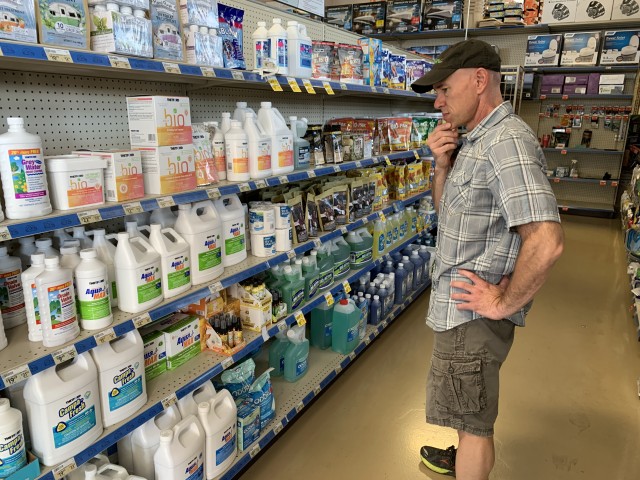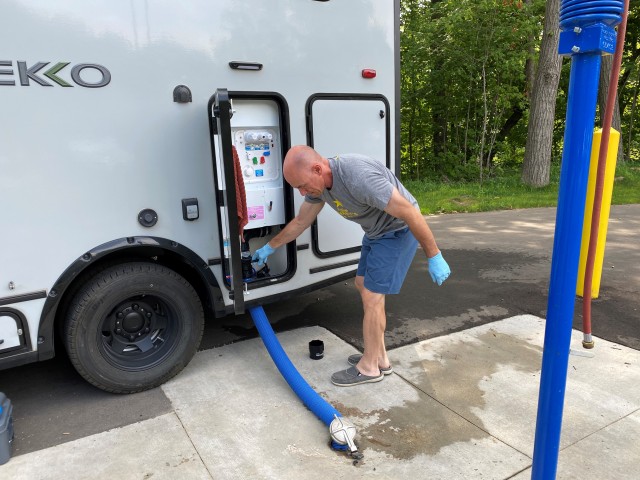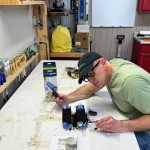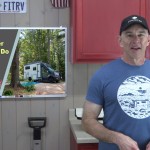This post may contain affiliate links.
“Hey! Where’s my regular blue stuff?!?”
That was my exact thought as I stood in the toilet chemical aisle at a Camping World store last year. The holding tank chemicals I’d been using for ages were nowhere to be found. They’d been replaced by other, similar-sounding, but not-quite-the-same alternatives.

What was the reason for this?!
And what should I use now?!
I had to know what was going on, so I started digging. The reason for the change in RV holding tank chemicals had to do with California Senate Bill 317, which was signed into law in 2019, and went into effect in 2021. This new law prohibits the chemicals formaldehyde and bronopol, among others, in RV holding tank additives.
The major drivers behind the new law weren’t environmentalists or public health agencies as you might think, but instead it was actually an alliance of RV park owners. It turns out there had been catastrophic failures in campground septic systems caused by formaldehyde and bronopol. These chemicals are effective at killing bacteria – too effective. The chemicals kill all the bacteria – including the helpful bacteria that keep a septic system working properly. When overloaded with these chemicals, campground septic systems can fail, and then potentially spill formaldehyde into the ground water, resulting in fines and remediation costs for the campground owners.
Formaldehyde and bronopol had been critical ingredients in holding tank chemicals. So, faced with the prospect of making multiple formulations for different locations, holding tank chemical manufacturers decided to just reformulate the ingredients across the board.
I talked to a few RV tank chemical manufacturers directly. “Yes, it was driven by California legislation,” said Kelly Robertson, a Senior Marketing Associate at Thetford, “but even outside of the California legislation, we’re seeing regulations in states like Wisconsin, Connecticut, and Rhode Island.”
So that’s the “what” and “why” of the chemical change. And unless you’ve hoarded a lifetime supply of your old toilet chemicals, you’re likely already using one of the new formulations. After coming out of the rabbit hole of research this took me down, I’ve realized the change is actually a good thing. The newer formulations are generally less toxic than their predecessors.
So, we now know there’s no longer formaldehyde or bronopol in your RV tank chemicals; that’s great. But that brings up more questions. 1) What exactly are they made up of now? And 2) With so many brands and new formulations, how do you choose which to use? Let’s take a deeper dive and sort all this out.
What a Holding Tank Chemical Should Do
Most RVers want two things from a holding tank treatment:
- Eliminate odors
- Break down waste
But literally EVERY SINGLE PRODUCT on the shelves makes those two claims, so it’s difficult to make a choice from reading labels. In addition to those two requirements, I’ll suggest two more that may be important to you depending on your RVing style:
- Keep working when the temperature rises
- Work in boondocking (low water use) situations
Now let’s discuss exactly what it is we’re trying to treat. Odors in sewage are produced as bacteria break down waste. There are two broad kinds of bacteria at work here. Aerobic bacteria, which require air to thrive, and anaerobic, which thrive in low or no oxygen environments. The byproducts of aerobic decomposition are primarily water and carbon dioxide. Whereas the byproducts of anaerobic decomposition are significantly worse smelling and include hydrogen sulfide gas and mercaptans. Manufacturers tackle black tank treatments in 4 very different ways.
The four main (well, now three) types of treatments for your RV’s black tank:
#1: Chemical Toilet Additives
These were the traditional products that contained formaldehyde and/or its cousin, bronopol. By most standards, they worked well. These highly effective anti-microbial chemicals were essentially the “nuclear option” of tank treatments. Ricky Stewart, Brand Manager at Unique Camping and Marine put it plainly, “The smells are being taken care of by essentially killing everything inside the tank.”
As most long time RVers know, these treatments typically didn’t stop at just eliminating the odors. They would replace the bad odors with a different, but still overpowering perfume smell. Over the years, this very distinct smell has become a part of what people perceive as “working”. The manufacturers are keenly aware of this, and in some cases, even use the same dyes and perfumes in their new formulations.
#2: Enzyme Tank Treatments
These days, the word “enzyme” is tossed around a lot for everything from bathroom cleaners to laundry detergents. But what exactly are enzymes? Are they alive? And how do they work?
First, enzymes are not alive. They’re protein molecules that catalyze (speed up) chemical reactions specific to that enzyme. Enzymes are produced by biological systems like people and bacteria, but can also be produced in a laboratory. You may be more familiar with enzymes from detergent: Want to break down a blood stain? There’s an enzyme to speed that reaction up. Similarly, breaking down toilet waste can also be accelerated by using enzymes.
“The science of enzymes has made leaps and bounds in the last 3 to 4 years even,” said Robertson, in describing the approach Thetford has taken with its new flagship product, Aqua Max – the replacement for Aqua Kem. Thetford uses not just one, but multiple enzymes in their new product. “We’ve targeted enzymes that work on specific things and that work together to accomplish what formaldehyde did in the past,” she added.
Other tank additive manufacturers have taken the same approach, and while none of them will tell you exactly which enzymes they’re using, most of them will say “enzyme” on the packaging.
But one of the problems with enzymes is that, while they’re great at breaking down their assigned waste products, they’re not directly targeted at removing the unpleasant black tank odors. While they will eventually work to remove some odors, you won’t get that instant smell replacement you might have experienced with a formaldehyde product in the past.
#3: Mineral Salt Tank Treatments
This broad group of holding tank treatments is very good at controlling odors. And unlike yesterday’s chemicals, they can control odors without having to cover it up with another fragrance. Examples of these kinds of tank treatments include Camco’s TST Max, and Thetford’s new Aqua Bio, as well as Happy Campers.
The active substances in these tank treatments include things like calcium nitrate, calcium carbonate, zinc sulfate monohydrate, and sodium percarbonate. If that sounds like a chemistry class to you, you’re not alone. But it’s OK, because these chemicals work.
For example, calcium nitrate (as used in Thetford’s Aqua Bio product) is used in large scale wastewater treatment plants. Sodium Percarbonate – the Oxy in non-chlorine bleaches – is used to oxidize foul smelling sulfur compounds. The antimicrobial zinc sulfate monohydrate used in Unique Camping and Marine’s Tank Odor Eliminator, may be familiar to those of you in in the pacific northwest as something that keeps moss from growing on roofs.
These chemicals are fantastic at eliminating odors, and they also work well in high-temperature and low-water situations. But one of their drawbacks is that by themselves, they do very little to break down waste.
#4: Bacterial Tank Treatments
Relative to the others, this class of holding tank treatments is newer. Representatives of this group include products like Unique’s RV Digest-It Holding Tank Treatment, CARAVAN Holding Tank Treatment, or TankTechsRx.
Bacteria are probably the best of the bunch here at breaking down waste – most natural decomposition processes use bacteria. They’re essential in septic systems. (Remember the California legislation about killing off bacteria that started this whole post?) These products work by replacing the bad (anaerobic) bacteria with an oversupply of good (aerobic) bacteria.
The bacteria supplied in commercial holding tank treatments are non-pathogenic – which means they won’t make you sick. (Think of yogurt, if that helps.)
You might also include something like Odorlos in this category. Odorlos doesn’t actually contain bacteria, but instead contains nitrates to help the aerobic (less smelly) bacteria out-compete the anaerobic (smelly) bacteria.
And that’s the secret to odor control with the bacterial additives: supporting the aerobic bacteria while keeping anaerobic bacteria in check.
There are some limitations to bacterial holding tank additives. Bacteria are living organisms. Extreme temperatures are a limiting factor on their effectiveness. “They prefer 40 degrees to 85 degrees just like we do,” said Stewart. “Once things go above that or below that, they start to trail off a bit.”
Also – Bacteria will require adequate oxygen and water to do their job. So their use in low water situations like boondocking will be problematic. Using adequate water, possibly more than you’re used to, is a necessary ingredient for success with these treatments.

So – Which Black Tank Chemical Should You Use?
As with many things in life, a little education is key. Unique’s Stewart put it this way: “If the average RVer was to do a little deeper dive into understanding the type of RVing that they do, as well as the type of treatments that are out there, it would help them match themselves up with a better treatment that meets their standards.”
I couldn’t agree more. So when you’re trying to decide what new holding tank treatment you’re going to try, my recommendation is to look at the different methods available, have a look at your own unique RVing style, and make a decision about what approach is going to work best for you.
For example: If you’re a full-hookup camper with large holding tanks, you’ve got the water, space and time to make enzyme or bacterial treatments work. But if most of your camping is in the desert Southwest, then you may want to look exclusively at enzyme treatments.
At the other extreme is my own situation. We have a cassette toilet, typically camp without hookups, and usually dump the cassette every two days. A mineral salt tank treatment will likely work best for us.
The good news is that most of the new formulations of tank treatments don’t require any behavior changes from the old formulations. “We always suggest to use plenty of water,” says Robertson, “but you don’t have to use MORE water.” Similarly, most of the tank maintenance behaviors you’ve learned will still apply with the new formulations.
So yes, you may have had to pick a new “go-to” tank additive. But with a little knowledge of the chemicals and your own RVing style, you should be able to pick a holding tank treatment that works just as well – or maybe better – than the old standby.











In Germany, we have Ammovit, a powder that is biodegradable and is used by farmers to break down the contents of their manure tanks. You can use it in RV tanks, but if you used chemicals in your RV tanks before, it takes about a month until the chemicals are washed out and the stuff actually works. So be patient. What comes out of your black tank is a grainy black liquid and you have to experiment a little with how much you need for your size of black tank in order to have good results. The farmers version is a 5 kg/10 pound bucket and costs about $ 20.-, which makes it also the cheapest holding tank treatment. Then the manufacturer saw, that more and more campers are using it, so they brought out the camping version, which is a 1 kg/2 pound pack that costs about $ 12.-. ))). Call it marketing))) It is available on Amazon, but don’t know, if they ship it to the US. But I am sure that US farmers have a similar product.
Interesting. I looked it up, and it’s mainly Iron Sulfate Tetrahydrate, with a little calcium carbonate thrown in. So if we classify it by the types in this post, it’s a mineral salt. It should be capable of quick odor reduction, and prevent the growth of microorganisms. (One of its other uses is to kill moss!)
That specific product isn’t sold here, but the raw chemical is available for $100 a ton!
Y’all are aware that formaldehyde also causes cancer, right? Everyone wants to complain until they get cancer. Inhaling formaldehyde (including from plywood and pressboard/MDF) increases your risk of nasopharygeal cancer and leukemia.
https://www.cancer.org/cancer/risk-prevention/chemicals/formaldehyde.html
Another reason to be glad tank treatments with formaldehyde are no longer widely available. As I said in the article, this change is actually a good thing since the new formulations are generally less toxic.
Appreciate this, thanks
Thanks for stopping by!
I have a cassette toilet and was very happy with it when using AquaKem. When California screwed it up for the rest of us being able to use AquaKem and other similar products and could no longer find real AquaKem I tried other products and this is my experience.
Happy Camper just flat out does not work. It does nothing to reduce odor. It changes the odor somewhat to a more organic smell but is still disgusting even in cold weather.
AquaMax and its derivatives. Seem to kind of work but only at ambient temperatures below 70 degrees. Oh and the fragrance is just nasty. Smells like old lady perfume.
Camco TST smells like someone pooped in a box of oranges.
None of these products did much to help liquify the waste. Happy Camper only slightly worked better in this regard to the rest.
It’s funny if AquaKem is so bad, how come it’s readily available in Europe, especially in light of the EU’s draconian environmental laws.
I’ve often wondered why Aqua Kem is still available in the EU.
Good article. I also find that adding a good dishwasher liquid, a good amount of water and a driving day every few weeks to a month (dumping as soon as possible after the drive) gets rid of a lot of the “source materials”. This used in combination with your favorite tank treatment in-between deeper cleanings does the trick for us. We do this in grey and black tanks. Now in our class A and Van, we do not have a cassette toilet, so YMMV.
We’ve been using Unique’s RV Digest-It for a year and it appears to be working great!
I know they make liquid and drop-ins. Which are you using?
You are correct that tank size will effect how well some products work. With a large black tank, enzyme, bacterial, and mineral will all work. But in a small cassette tank enzyme and bacterial may not work as well as they don’t have the volume and time to “digest” the wastes. I’ve been using AquaBio in my EKKO which seems to work for me. I’m going to try CampaFresh based on some comments I have seen that it seems to work better in cassettes.
Unfortunately, there’s still not a product on the market that is specifically designed for the tough environment in a cassette.
Very informative. Thank you. We try to dump our cassette as soon as possible, before we start driving. It seems the ‘sloshing’ increases the spread of “the smell”. I’m counting on you to find a solution
Can you combine treatments? Enzymes break down waste but don’t address odors, while mineral salt treatments do the opposite. So would a bit of both let you approach it from both sides, or do they wind up working against one another?
Yes, and I’ve done this.
The overall effectiveness will depend on the individual products used. But there’s nothing that’s always “bad” about mixing.
The one exception to this type would be: I wouldn’t mix mineral salts and bacterial treatments. The mineral salts would likely kill off the bacteria – reducing their effectiveness.
For venting your cassette, you might use the same approach as for a composing toilet, a little computer fan running 24/7. The hardest part of that would be designing a clever trap to make sure the black stuff doesn’t make it to the fan.
And, as in the composting case, you might even fashion little screens on the inlet to make sure flies stay out,
In Europe we have the SOG System since about 15-20 years. It was invented especially for cassette toilets, that over 90 % of RV’s have here.
It is basically an extraction fan that extracts the odors from the cassette and vents them through a filter to the outside outside of the RV, usually mounted to the access door for the cassette. You won’t smell anything outside of the RV. Some RV manufacturers have it as an option on their factory price list or you can have it installed by the dealer or even do it yourself. Price is between 150-300.-.
Here is a link to their website in english. They are based in Germany.
https://www.sog-systeme.de/?lang=en
Hope this helps! Matt
Yep. We actually have the SOG installed on our RV.
I find we still need chemicals.
I’ve tried various types of the new stuff, doesn’t work, especially during hot weather.
I’m a cassette user and dump into the sewer. There’s no reason to ban the old stuff when the toilet is dumped into the municipal sewer.
The biggest problem with the cassette systems are that they vent inside the rig – and the hotter it gets, the more they vent.
I’m looking at a way to fix this. Maybe I’ll have a product to test out soon.
I can’t wait!!
Hello Jim.
Great Holding Tank Chemical FYI!
Still recovering from an extended Covid-19 recovery!! Quick question. Did I miss one of your postings that you changed and/or replaced your original (5gal) toilet installation?
Thanks.
We still have the same cassette toilet. But I do use black tank chemicals in it.
i thought the ekko had a cassette toilet not a black tank. Cassette Toilet Capacity (gal.) = 5.
Correct. It does.
I still use black tank chemicals in ours.